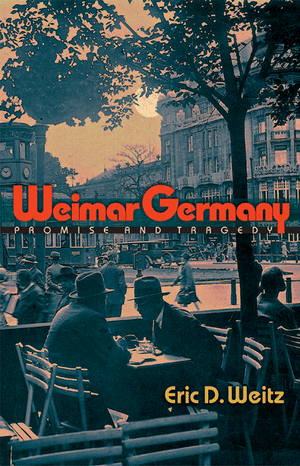Weitz, Eric D. Weimar Germany: Promise & Tragedy. Princeton: Princeton University Press, 2007.
In this survey of the German Weimar era that is both open to a non-academic audience and helpful to scholars, Weitz offers a well-written and engaging look into a vibrant, bygone age. The majority of the book is dedicated to studying Weimar’s vivacious, multi-faceted and lively culture. That is not to say that Weitz ignores politics, but he does aim to show that the Weimar Republic was more than just unstable politics, more than just a prelude to the Third Reich (5).
A main theme of Weitz’s book is the Weimar Republic’s perceived relationship to modernity. He convincingly shows that the idea of modernity was on Germans’ minds and at the heart of political debates, artistic movements, and even city planning. In one chapter, Weitz leads readers on a leisurely stroll through Weimar Berlin, letting them experience the hustle and bustle of Berlin life “first hand.” He refers specifically to the Romanische Café, what he calls the “perfect symbol of Weimar politics and society.” It’s “lively, democratic, engaged, and divided and divisive, unable to speak beyond its own circle” (77-78). People of different backgrounds and political loyalties met in the café, yet each gravitated to their own tables and corners; they were democratic and diverse, yet broke themselves into small cliques. To Weitz, this was how the Weimar Republic itself worked.
During the Weimar period, artists and architects attempted to create Gesamtkunstwerke (synthetic works of complete artwork), like Bruno Taut and Martin Wagner’s “Hufeisen,” an apartment complex shaped like a horseshoe so that every occupant could see all other apartments, thus fostering a sense of community (181). Other artists believed that architecture and paintings could fundamentally change society for the better. Walter Gropius, founder of the Bauhaus school, for example, felt filling society with modern architecture would take mankind into the modern world by transforming and harmonizing society (194). Department stores helped usher in the New Woman by carving out a “safe” space for women in the public sphere (55). New technology allowed for classic operas and symphonies to be presented to the new “masses,” while also creating new forms of artwork and consumption: films. But not everyone was happy with this new culture, with its new gender norms, economic system, and modes of authority. Conservatives of all colors protested on the streets and in the Reichstag.
This cultural vitality coexisted alongside (and also contributed to) political instability. The republic was hit by a series of crises, and the Great Depression in particular became a crisis of the republic’s legitimacy (122). The warding off of groups into smaller fractions was a symbol of the inefficiency, not vitality of democracy. By 1928, there were forty-eight parties in the Reichstag, rendering it difficult to legislate. A series of constitutional articles, (particularly Article 48) gave the Federal President (who otherwise had no direct power on the daily governmental business) unprecedented authority over the Chancellor and Parliament, setting up a “presidential dictatorship,” that for Weitz signaled a political overthrow of democracy in Germany five years before the Nazis took power (351). The Nazis, Weitz argues, simply tapped into the new rhetoric of the radicalized Right, gaining success only by using mass mobilization and new inventions to spread their message of a return to stability and prosperity. Ultimately, Weimar’s failure came from its instability, the fact that scores of factions were taking stabs at it from every angle. The final blow came when a handful of conspirators (conservative government men and big, industrial businessmen) helped the Nazis to power (358).

